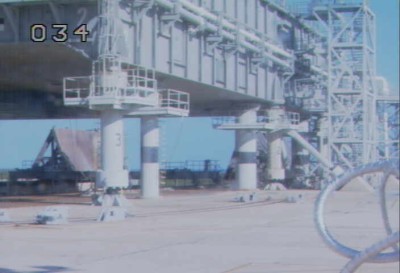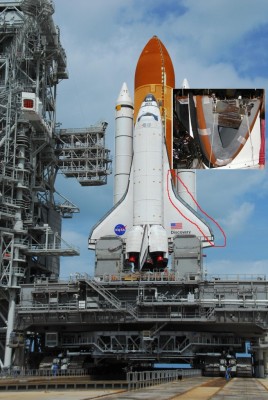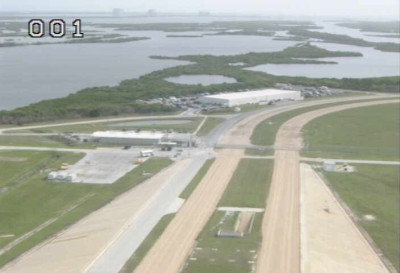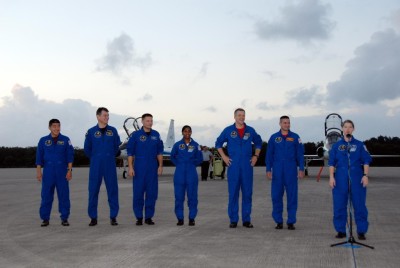Movie of Rotating Service Structure re-attached to Shuttle
 Yesterday, I captured NASA public webcam images and created a small animation from them. It shows how the rotating service structure (RSS) is being reattached to space shuttle Discovery.
Yesterday, I captured NASA public webcam images and created a small animation from them. It shows how the rotating service structure (RSS) is being reattached to space shuttle Discovery.
The RSS had to be rolled back to carry out the APU hotfire test, which was postponed to yesterday due to bad weather. I have not yet heard of any test results, but assume all went well.
The video is the ground-level MLP view, the actual space shuttle can not be seen. When the video starts, watch the shadows. You will see the RSS shadow before you see the RSS itself.
To watch the video, please go to my personal site – it is too big to fit into this blog’s theme. The link is:
APU hotfire test about to begin
 The APU hotfire test seems to be carried out right now. The rotating service structure (RSS) has just moved to parking position. The hotfire test was originally scheduled for immediately after space shuttle Discovery’s rollout to the pad, but had to be postponed due to bad weather at Kennedy Space Center. It was re-scheduled post FRR, which is today.
The APU hotfire test seems to be carried out right now. The rotating service structure (RSS) has just moved to parking position. The hotfire test was originally scheduled for immediately after space shuttle Discovery’s rollout to the pad, but had to be postponed due to bad weather at Kennedy Space Center. It was re-scheduled post FRR, which is today.
There was some discussion whether or not NASA would do this test (there seems to be no hard requirement), but it now seems to be done.
News on Discovery’s wing leading edge problem
The problem with Discovery’s wing leading edge is now being reported by mainstream media (the issue was first reported by nasaspaceflight.com). So it is definitely no rumor any longer and it also has been confirmed by NASA.
The good new, though, is that this issue is unlikely to actually defer the launch. According to Yahoo News, space shuttle program manager Wayne Hale said that space shuttle Discovery’s launch later this month should not be delayed to replace three possibly defective heat shields. He “will recommend to his NASA bosses that Discovery go ahead with its planned October 23 liftoff”.
This statement was made on Wednsday after a program level flight readiness review (FRR). However, Hale has ordered to gather more data on the wing leading edge problem. A final decision is expected after next weeks agency level flight readiness review.
The reason a go ahead seems likely is that only one body inside NASA (the NESC) has recommended replacement. Other teams have already assessed the issue and found the risk to be acceptable. Discovery has been in orbit twice with the heat shield in its current state and there were no indications that the problem has worsened during the flight. Thus, the majority of NASA teams do not anticipate any real problem over here.
The current situations resembles somewhat the tile issue that came up during STS-118 earlier this year. There, a problem with the tiles was detected and one NASA group voted to fix this in orbit. All other groups concluded that it would be safe to fly as is. After some controversy, no fix was applied and the reentry was perfectly well, just as expected.
It is important to note that NASA groups should voice even the slightest concern. It is then the responsibility of the team as whole to decide whether or not the issue is a real show stopper. As it right now looks, the wing leading edge problem seems unlikely to be one. In any case, I trust NASA management to do the right thing.
With that said, I hope for an October, 23rd launch and a great and problem-free mission.
Heat Shield Trouble looks worse…
The more I read about space shuttle Discovery’s heat shield trouble, the worse it looks. News not yet generally available yet points to a potentially serious issue, which could actually make a launch in the October/November time frame impossible. Thankfully, nothing is finalized yet and there still is hope the situation is not as bad as it currently looks.
As far as my travel plans are concerned: While it is too early to panic, I have begun to think about fall back scenarios. I am right now checking what I can cancel and at what cost. From the cost perspective, it looks frightening, too. Is this really supposed to be the end of my launch viewing trip, at least for this launch window…?
I’ll post updates as soon as I get more news…
Trouble with space shuttle heat shield?

There is been some rumor about trouble with Discovery’s heat shield for a while now. Nothing is yet confirmed, but at the public raumfahrer.net forum a message popped up that there may actually be trouble.
This is the first public posting on the problem. If it really exists, that would probably be extremely bad: if some of the so called RCC (reinforced carbon carbon) elements would be damaged, the repair would probably be very time consuming. That could cause not just a slight delay but in worst case make a launch of STS-120 in the set launch window impossible. Of course, this would be extremely bad news for me personally, too.
The RCC (Reinforced Carbon-Carbon) panels are a vital part of the space shuttle’s thermal protection system. They gained notoriety as the cause of the Columbia disaster. During Columbia’s STS-107 launch, a RCC panel was damaged by foam debris falling from the external tank. On re-entry, that lead to ultra-hot gases entering the orbiters inside, which in turn lead to melting and break up of the space ship. All crew members lost their lives in this accident.
So problems with the RCC panels are to be taken seriously. And I am sure NASA will. What gives me hope is that so far no official word from NASA is out. So, hopefully, these rumors are exactly that: rumors. I hope to get better information in the next few hours. Actually, I am very eager about any news: after all, it would more then depress me if I needed to cancel my launch viewing trip at this stage – especially as so far everything went exceptionally well…
Discovery Crew arrives at Kennedy Space Center
pad flow still on track
From what I have read over the weekend, the launch pad processing of space shuttle discovery is still on track. Fuels have been loaded to the shuttle. They are used to power all sort of auxiliary systems. A countdown test with the crew on site is scheduled for mid this week. That countdown test seems also to be a chance to do the APU hotfire test, which still is considered.
NASA my skip APU hotfire test, crawler headed back…

Still, no official news from NASA. But from what I have gathered on several forums on the Internet, Discovery is still on schedule. A tight schedule – as said yesterday, there seems to be only a few hours of contingency left.
In spite of this, NASA considers to drop the so-called APU hotfire test. APUs provide power e.g. for hydraulics during re-entry. The APU test was originally scheduled for shortly after arrival at the pad. However, it could not be carried out due to bad weather. It is now targeted for next Thursday — if not being canceled. Canceling seems attractive to NASA, as it would probably save around one day of contingency. And the APU test is not considered absolutely vital – it is recommenced only after a major overhaul of the orbiter (which, however, seems to have happened).
As a side-note, the crawler transporter has now left the pad. Look at the picture above — not to long ago this was where the crawler parked. Driving back seems to be a bit quick, as it usually stays until shortly before launch. Maybe this is another indication that NASA is very serious on launching as quickly as possible.
buffer time is being eaten up…
Still, few news from NASA. But some Internet forums have coverage. According to them, the contingency day that was left is shrinking. So there seem to be only some hours of contingency (buffer time) left. If that contingency is eaten up, the launch will be delayed. That, in turn, could pose problems for the next mission, STS-122, as the schedule is very tight.
In some forum it is already being speculated if NASA is skipping some tests to save time. I think the guys at NASA know well what they are doing. I also believe they are quite responsible people. So, at least I hope, if they skip a test it is safe to do so.
Anyhow, it’ll be interesting to see if the launch date slips — and how this affects my travel schedule.
Oh, yes: sorry, folks, so far no new interesting pictures. If find some, I’ll post as soon as I do…

